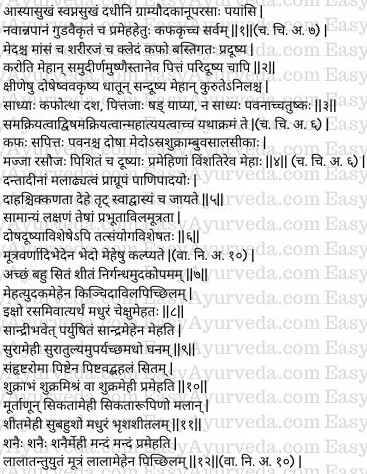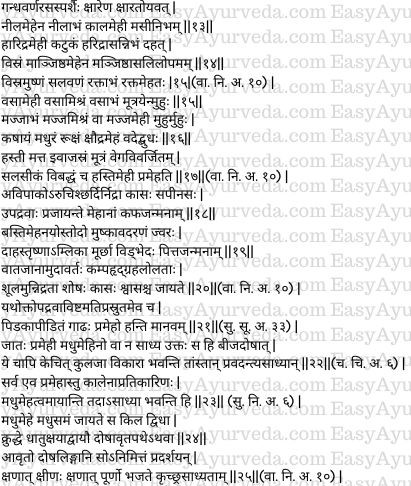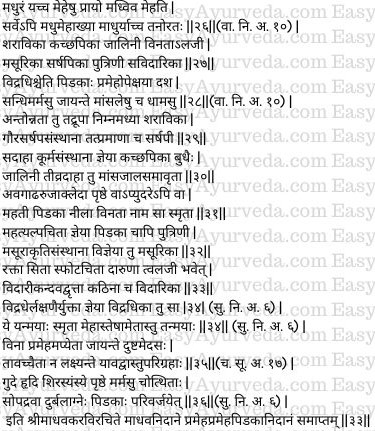Madhava Nidana Chapter 33 Prameha, Prameha Pidaka Nidanam
This article explains Madava nidana 33rd chapter “Prameha, Prameha Pidaka Nidanam”. Causes, pathology and symptoms of Prameha and Prameha Pidaka are explained in this chapter. Prameha is explained as urinary disorders with increased urination.
Read – Acharya Madhavakara: His Work ‘Madhava Nidana’, Legacy, Amazing Facts

Table of Contents
Prameha Nidana
Etiological Factors of Prameha
- sitting on soft cushions and comfortable beddings for long periods (thus avoiding physical activity)
- sleeping for long hours
- excessive use of curds
- excessive consumption of flesh of domestic animals (and birds) or of those living in aquatic or of marshy places
- excessive consumption of milk and its products / preparations
- excessive use of fresh grains and fresh water (rain water)
- excessive use of puddings made of jaggery / sugar (and other edibles made of jaggery or sugar) and
- all other similar factors which bring about increase of kapha in the body (kapha aggravating foods and activities) (1)
Read – Prameha: Ayurvedic Approach To Urinary Disorders

Prameha Samprapti
Pathogenesis of Kaphaja Prameha – Kapha which has undergone increase due to its own etiological factors and located in the urinary bladder, vitiates the medas (fat), māṁsa (muscle) and kleda (body fluids), and causes kaphaja prameha.
Pathogenesis of Pittaja Prameha – Pitta which has been aggravated due to excessive consumption of foods which are hot in nature (and other pitta aggravating foods and activities) and located in the urinary bladder vitiates the fat, muscle and body fluids (as described in kaphaja prameha) and causes pittaja prameha.
Pathogenesis of Vataja Prameha – The vata aggravated due to decrease of kapha and pitta would vitiate muscle-fat, bone marrow, ojus (essence of all the tissues) and serum (plasma), pulls them into the urinary bladder and causes vataja prameha.
Read – Charaka Prameha Nidana: 4th Chapter
Prognosis of doshaja types of prameha
The ten kinds produced by kapha are easily curable. This is due to the similarity in properties of the causative doshas and vitiated tissues. Due to this similarity the treatment for doshas and tissues will be similar and hence makes these conditions curable.
The six kinds of pittaja prameha are manageable (controllable). This is due to the dissimilarity in the properties of the causative doshas and vitiated tissues. Due to this dissimilarity the treatment for the involved doshas and tissues will be opposite in nature. Therefore, this condition becomes manageable (persists throughout the life but would be under control if timely and prompt treatment is given i.e., requires frequent treatment to manage the disease and have it under control).
The four kinds of vataja prameha are said to be incurable. This is due to the grave consequences and severe complications caused due to severe and quick destruction of tissues due to aggravation of vata and also due to the opposite nature of the treatment for the involved doshas and tissues. (2-3)
Doshas and Dushyas (tissues and other components of the body) involved in the pathogenesis of Prameha
Involved doshas – In all the twenty varieties of prameha, vaata, pitta and kapha together form the causative doshas.
Involved dushyas – medas (fat), asrk (blood), sukra (semen), ambu (body fluids), vasa (muscle fat), lasika (tissue fluid), majja (marrow), rasa (lymph), oja (essence of all the dhātus) and pishita (muscle tissue) are the dushyas involved in the causation of prameha. (4)
Read – Charaka Prameha Chikitsa – 6th chapter
Premonitory symptoms of Prameha
Premonitory symptoms of prameha are accumulation of dirt on the teeth (mouth, palate, throat, tongue, eyes, nose, and ears), feeling of burning sensation in the palms and soles, stickiness of the skin all over the body, thirst and manifestation of sweet taste in the mouth. (5)
Prameha Samanya Lakshana
General symptoms of Prameha
Increased quantity and turbidity of urine are the characteristic features of prameha. Due to the specificity of doshas and tissues and combination of doșhas and dūşyas, different colours are seen in the urine and the prameha (diabetes) are classified depending upon the colour of the urine, etc. (6-7)
Read – Diabetic carbuncle – Ayurvedic Understanding And Treatment Modalities
Kaphaja Prameha
Types and symptoms
Udakameha Symptoms are – The urine is clear, more in quantity (copious), white, cold, odourless, resembles water, with little turbidity and stickiness.
Iksumeha Symptoms – The urine is sweet – like the juice of sugarcane.
Sandrameha Symptoms – In this condition, the urine kept undisturbed for a while in a vessel becomes thick and dense.
Surameha Symptoms – Here, the urine resembles sura i.e., alcoholic beverages prepared with flour, clear at the top and thick sediments at the bottom.
Pistameha Symptoms – In this condition the urine appears thick like flour (as if mixed with flour) and is white in colour. The patient will experience horripilation.
Sukrameha Symptoms – Here, the urine either resembles (appears like) semen or is mixed with semen.
Sikatameha Symptoms – In this condition the urine contains small particles which resemble sand.
Shitameha Symptoms – In this condition the urine is large in quantity (copious), sweet in taste and very cold.
Sanairmeha Symptoms – In this condition the urine is voided frequently and very slowly.
Lalameha Symptoms – Here the urine resembles saliva along with the appearance of thread like structures and is sticky in nature.
(These ten varieties are predominantly kaphaja). (7-12)
Read – Diabetes: Ayurvedic Treatment, Remedies, Prevention Tips

Pittaja Prameha
Types and symptoms
Ksarameha Symptoms – In this condition the urine resembles the solution of alkali in smell, colour, taste and touch.
Nilameha Symptoms – The urine is blue in colour in nilameha.
Kalameha Symptoms – In this type the urine resembles the colour of ink.
Haridrameha Symptoms – In this condition the colour of the urine resembles that of turmeric (deep yellow). The urine is pungent in taste and the patient experiences a burning sensation during urination.
Manjisthameha Symptoms – The urine in this type of pittaja prameha resembles the decoction of Manjistha (Rubia cordifolia) and smells foul.
Raktameha Symptoms – The urine in this condition has a foul smell, hot, has salty taste and resembles blood in colour (is blood red in colour). (13-14)
(The above six varieties are predominantly pittaja.)
Read – Hyperglycemia – Ayurvedic Analysis, Treatment Strategies
Vataja Prameha
Types and symptoms
Vasameha Symptoms – In this condition the urine voided is either mixed with muscle fat and resembles muscle fat in colour, smell etc and is voided frequently.
Majjameha Symptoms – In this condition the person frequently voids urine mixed with marrow and also appears like marrow in colour, smell etc.
Ksaudrameha Symptoms – It is a condition in which the urine is astringent and sweet in taste and is dry (non-sticky, non-unctuous).
Hastimeha Symptoms – The person suffering from this condition continuously passes urine like an intoxicated elephant. The urine is mixed with laskia i.e., tissue fluid and is composed of matted (small nodular) material.
(The above four varieties are predominantly vātaja.) (15-17)
Prameha Upadrava
Symptoms of incurability
Prameha of long duration (which has become chronic), associated with the above-mentioned complications, in which there is elimination of very large quantities of urine and appearance of carbuncles / tubercles (or ulcers) on the body is going to kill the patient (is incurable). (21)
A person who is born with prameha (hereditary diabetes) or a person who is suffering from madhumeha are said to be incurable because of defect in genes. Likewise, many other hereditary diseases also are said to be incurable. (22)
Transformation of all kinds of prameha into madhumeha
All varieties of prameha, if not treated at appropriate time, will ultimately get transformed into madhumeha. In this condition they will become incurable. Madhumeha – In Madhumeha, the urine is like honey (sweet in taste). Madhumeha is of two kinds. One type of madhumeha is caused by vata increase caused by dhatu ksaya – depletion of tissues. The other type of madhumeha is caused by obstruction of (the channels / passages of) vata by other doshas. (23-24)
In case of madhumeha caused by avarana i.e., obstruction of vata by other doshas, the symptoms of doshas which appear are sometimes mild and sometimes severe in nature. Gradually the disease becomes difficult to cure.
Read – How Turmeric Helps in Diabetes Treatment: 7 Ways
Definition of Madhumeha
Any variety of prameha in which the urine is sweet like honey and the whole body also becomes sweet is to be named as Madhumeha. (25-26)

Prameha Pidaka: Diabetic carbuncles
The ten types of carbuncles caused by (related to) prameha are –
- saravika
- kacchapika,
- jalini,
- vinata
- alaji,
- masurika,
- sarsapika,
- putrini,
- vidarika,
- vidradhika
They appear on joints, vital parts and other fleshy parts of the body. (27-28)
Symptoms of Prameha Pidakas
Saravika – It resembles a saucer with elevated edges and a depressed centre.
Sarsapika – It is similar to white mustard seeds in colour and size.
Kacchapika – This resembles the shell of a tortoise and is associated with burning sensation.
Jalini – This carbuncle appears like a sieve of muscle fibres and presents with severe burning sensation.
Vinata – It usually appears on the back or abdomen. The carbuncles are hard, blue, blue in colour, big in size and are associated with pain and exudation.
Putrini – It manifests in the form of a big eruption surrounded by smaller eruptions all around it.
Masurika – It resembles the shape and size of a masura (pea).
Alají – It is surrounded by red or white coloured blisters and is considered to be a dreadful condition.
Vidarika – It is round and hard just like the tuber of Vidari (Pueraria tuberosa).
Vidradhika – This is an eruption (carbuncle) which will present with all the features of an abscess.
Read – Diabetic carbuncle – Ayurvedic Understanding And Treatment Modalities
These prameha pidakas are also caused by the same doshas which cause the pramehas which are responsible for the manifestation of these pidakas. (The same dosha which causes a particular prameha will also be responsible for the causation of a pidaka resulting from that particular prameha. To put it in simple words, the dosha causing a particular type of prameha and its pidaka is the same.) (29-34)
The pidakas might also occur without the presence of prameha when the medas i.e. fat / adipose tissue gets severely contaminated (vitiated). (This means that pidakas need not be essentially caused by prameha. Severe vitiation of fat tissue may also cause these pidakas independently). But they cannot be recognized (their specific symptoms will not become evident) until they get localized in specific parts of the body. (35)
The patients who have developed these pidakas in the anal region (rectum), region of the heart, head, shoulders (scapular regions, shoulder blades), back and vital parts of the body, associated with complications and manifesting in those who have poor digestive fire (capacity) are to be refused treatment (because these conditions are incurable). (36
Thus ends the chapter on Prameha Prameha Pidaka Nidanam in Madhava Nidana text written by Acharya Madhavakara.











